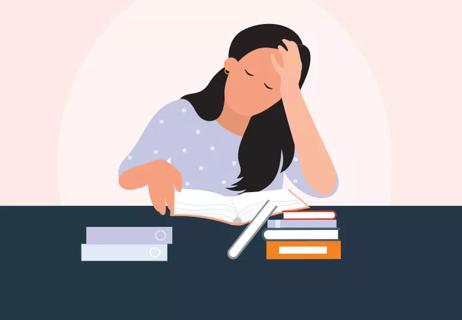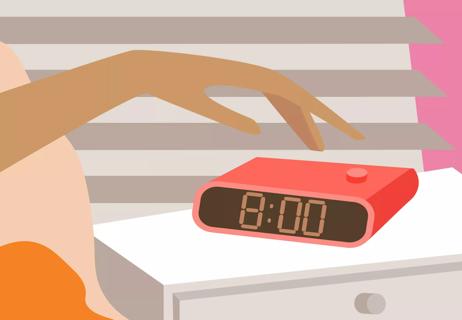First approved drug may soon be available to treat this rare sleep disorder

Though narcolepsy is fairly well-studied and well understood by medical professionals, there’s far less data available on its close cousin, idiopathic hypersomnia.
Advertisement
Cleveland Clinic is a non-profit academic medical center. Advertising on our site helps support our mission. We do not endorse non-Cleveland Clinic products or services. Policy
Classified as a rare disorder by the National Institutes of Health, idiopathic hypersomnia (IH) may actually be more common than doctors previously realized — and a new medication could offer desperately needed wakefulness to those who live with this debilitating disorder.
Sleep specialist Nancy Foldvary-Schaefer, DO, MS, is an investigator in medical trials of lower-sodium oxybate, a new medication undergoing review by the U.S. Food and Drug Administration (FDA) to become the first approved treatment for IH. She talks about idiopathic hypersomnia, including why it’s so understudied, and what this new medication may be able to do for people with IH.
There’s being sleepy, and then there’s having idiopathic hypersomnia. IH is characterized by chronic excessive daytime sleepiness (known as EDS) that interferes with normal daily activities, such as work and hobbies.
“People with IH have an irresistible need to sleep for long periods of time,” Dr. Foldvary-Schaefer explains, “but their sleep is not refreshing.”
Other symptoms include:
Advertisement
If you have IH, the overwhelming need to sleep may be incapacitating.
“People sometimes avoid social situations just to avoid falling asleep at inappropriate times which can be incredibly isolating,” Dr. Foldvary-Schaefer says. “There can also be limitations around driving and work — the struggles really go on and on.”
Right now, there’s no straightforward or all-that-helpful way to treat idiopathic hypersomnia. Doctors sometimes prescribe traditional stimulants, including:
But these medications may not really do the trick for people with IH.
“The medicines we use haven’t been studied specifically for patients struggling with debilitating hypersomnia,” Dr. Foldvary-Schaefer says. “We know these medicines don’t normalize wakefulness.”
A new drug in the works is expected to become the first FDA-approved drug for idiopathic hypersomnia. Trial research shows that lower-sodium oxybate (LXB) meaningfully reduces symptoms of IH and is generally well tolerated by patients.
“Compared with placebo, LXB significantly reduced the severity of every clinically meaningful symptom of IH,” Dr. Foldvary-Schaefer says.
The medication is the result of increased studies about narcolepsy, which has led to an increased interest in IH, as well.
In 2002, the FDA approved sodium oxybate as a treatment for narcolepsy. But people with narcolepsy have a higher prevalence of cardiovascular disease and sodium can contribute to that — which means that a high-sodium medication is risky for that population.
“This new drug, lower sodium oxybate, has the benefit of 92% less sodium,” Dr. Foldvary-Schaefer says, “so we believe that it’s going to be not only equally effective but safer for all populations.”
People with IH don’t experience cataplexy, which is associated with type 1 narcolepsy. Cataplexy is a sudden loss of muscle tone in reaction to strong emotion, especially laughter and excitement. That muscle weakness lasts anywhere from a few seconds to several minutes.
Type 2 narcolepsy — sometimes known as narcolepsy without cataplexy — presents similarly to idiopathic hypersomnia. So how can doctors tell them apart? The two disorders can be differentiated only through a 24-hour sleep test known as a Multiple Sleep Latency Test (MSLT), which determines how quickly you fall asleep during the day as a measurement of excessive daytime sleepiness.
Even then, though, idiopathic hypersomnia can be difficult to diagnose.
“In making a diagnosis of idiopathic hypersomnia, there are no readily accepted biomarkers or blood tests,” Dr. Foldvary-Schaefer says. “This leaves doctors in a quandary at times, because we’re trying to differentiate these disorders using the clinical history and a test that is imperfect. It’s just not very black and white yet.”
Advertisement
She’s hopeful that further research will result in a better understanding of IH, including how to diagnose and effectively treat it.
Studies show that about one in 2,000 people has narcolepsy, but no thorough data is yet available about the prevalence of idiopathic hypersomnia. A recent review, though, suggests that IH is as common as narcolepsy.
“There is now more patient information out there related to IH, probably as a result of increased clinical trials for narcolepsy,” Dr. Foldvary-Schaefer says. “Although the prevalence seems to be increasing, that’s probably not because the disease is becoming more common; it’s because people are finally seeking help.”
Advertisement
Learn more about our editorial process.
Advertisement

Pain, light exposure and anxiety are just a few factors that could be waking you up in the middle of the night

Create a consistent wake-up schedule, don’t nap too long and follow the ‘20-minute toss-and-turn rule’ when you can’t sleep

If you’re feeling short of breath, sleep can be tough — propping yourself up or sleeping on your side may help

Changing hormones, mental health issues and a higher risk for sleep disorders can all impact women’s sleep needs

Keeping a sleep diary and seeing a sleep specialist can help you stay asleep and get the ZZZs you need

This social media sleep hack with tart cherry juice and magnesium could be worth a try

Sleep disorders, diet and mental health can affect the quality of your sleep

It’s normal to oversleep occasionally, but sometimes, there might be an underlying cause

If you’re feeling short of breath, sleep can be tough — propping yourself up or sleeping on your side may help

If you fear the unknown or find yourself needing reassurance often, you may identify with this attachment style

If you’re looking to boost your gut health, it’s better to get fiber from whole foods